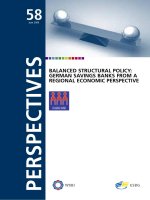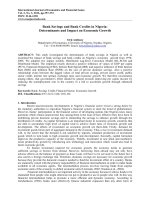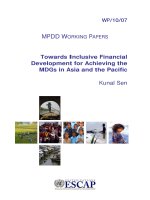Asia and Pacific Regional Economic Outlook––October 2012 Update potx
Bạn đang xem bản rút gọn của tài liệu. Xem và tải ngay bản đầy đủ của tài liệu tại đây (566.03 KB, 5 trang )
FOR RELEASE:
In Japan: 11:30 A.M., October 12, 2012
In Washington, D.C.: 10:30 P.M., October 11, 2012
Asia and Pacific Regional Economic Outlook––October 2012 Update
Growth in the Asia-Pacific region has slowed. External headwinds played a major role, as the recovery in advanced
economies suffered setbacks. Weaker momentum in China and India also weighed on regional economies. For Asia
as a whole, GDP growth fell to its lowest rate since the 2008 global financial crisis during the first half of 2012. With
inflationary pressures easing, macroeconomic policy stances remained generally supportive of domestic demand
and in some cases were eased further in response to the slowdown. More broadly, financial conditions remain
accommodative, and capital inflows have resumed. Going forward, growth is projected to pick up very gradually,
and Asia should remain the global growth leader, expanding over 2 percentage points faster than the world average
next year. However, considerable downside risks remain, in particular with regard to the euro area crisis. The
priorities for policymakers are to support noninflationary growth, maintain financial stability, and remain
responsive to weaker-than-expected outcomes. Refocusing structural and fiscal reform efforts toward sustained and
more inclusive growth remains a priority.
Growth in Asia has been somewhat lower than
previously projected on setbacks to the global
recovery
Although a rebound from earlier natural disaster
disruptions helped spur growth in the first quarter of
2012, that activity has now slowed markedly
(Figure 1). Adverse trade spillovers from weakness in
the euro area and beyond have taken their toll on
Asian exports. For Asia as a whole, real GDP growth
averaged 5½ percent (year over year) in the first half
of 2012, well above the global average, but the lowest
rate since the 2008 global financial crisis. Domestic
factors also contributed to the slowdown in China and
especially in India, reflecting deliberate efforts to
engineer a soft landing in the former and weakening
investor sentiment adding to supply constraints in
the latter. In Japan, a slowdown in consumption drove
the recent deceleration in growth after the
policy-driven pickup in early 2012. Several
Association of Southeast Asian Nations (ASEAN)
economies, led by Indonesia, Malaysia, the
Philippines, and Thailand, have bucked regional
trends, with growth remaining close to potential, in
Figure 1. Asia: Changes in Real GDP at Market Prices
(In percent)
part supported by public investment. Australia has
also weathered global headwinds relatively well, in
particular as mining-related investment expanded
strongly.
Against the backdrop of weaker activity and declining
global commodity prices, headline inflation fell
further during the first half of 2012, in many cases
within comfort zones (Figure 2). As a result, central
banks in the region have either left unchanged or
-9
-6
-3
0
3
6
9
12
15
2011:Q3
2011:Q4
2012:Q1
2012:Q2
2011:Q3
2011:Q4
2012:Q1
2012:Q2
2011:Q3
2011:Q4
2012:Q1
2012:Q2
2011:Q3
2011:Q4
2012:Q1
2012:Q2
2011:Q3
2011:Q4
2012:Q1
2012:Q2
Industrial
Asia
East Asia
(excl. China)
ASEAN China India
Quarter over quarter (SAAR) Year over year
Sources: CEIC Data Company Ltd.; Haver Analytics; and IMF staff calculations.
Asia and Pacific Department REO Update, October 2012
2
begun cutting policy rates. Largely accommodative
monetary policy stances, with real policy and lending
rates still 150 basis points below the pre-2008 levels
on average, have thus helped maintain favorable
conditions for domestic demand. In addition to robust
retail sales growth, continuing even at double-digit
rates in China, private sector credit growth has
remained steady (Figure 3), in particular in many
ASEAN economies where credit-to-GDP ratios are
above trend. Unemployment, while edging up, has
remained close to its pre-2008 lows.
Figure 2. Asia: Headline Consumer Prices
1
(Year-over-year percent change)
Figure 3. Asia: Credit to Private Sector
1
(Year-over-year percent change)
Capital inflows have resumed since the beginning of
the summer, reflecting an easing of global financial
tensions after a period of heightened volatility in the
first half of 2012 (Figure 4). While shifts in portfolio
flows were driven by swings in volatile equity flows,
Asia’s local bond markets have consistently attracted
foreign investors, suggesting a relative strength in
fundamentals and a dearth of alternative safe stores of
value. Indeed, sovereign bonds and CDS spreads
have mostly returned to their post-crisis lows.
Moreover, the impact of European bank deleveraging
in Asia, which appears to have paused in the first
quarter of 2012, has had a manageable impact on
regional financial systems so far. Claims of European
banks are generally moderate relative to other
emerging market regions, and funded in many cases
by a large domestic deposit base. Growing
cross-border activity afforded by healthy balance
sheets from banks in the region (including Japan and
Australia) has provided an additional buffer.
Figure 4. Emerging Asia: Equity and Bond Funds Net Flows
(In billions of U.S. dollars)
The near-term outlook remains subdued, while
downside risks may be elevated for longer
Asia’s growth is unlikely to pick up in the second half
of 2012 as was expected in the April 2012 Asia and
Pacific Regional Economic Outlook, given the recent
deterioration of a broad range of indicators
encompassing activity variables from industrial Asia,
the large emerging Asia growth leaders, and the
smaller export-dependent economies (Figure 5).
Overall, after having slowed in 2011, Asia’s growth is
forecast to moderate further in 2012 to 5½ percent,
about ½ percentage point below 2011 and our April
2012 forecast. That said, Asia will remain the global
growth leader, expanding over 2 percentage points
faster than the world average. A modest growth
pickup to about 6 percent in 2013 could result mostly
from strengthening external demand—itself helped
-5
0
5
10
15
20
Japan
New Zealand
Australia
Malaysia
China
Korea
Thailand
Philippines
Hong Kong SAR
Singapore
Indonesia
Vietnam
India
Latest available December 2011 2005-07 average
Source: IMF staff calculations.
1
Latest available data are as of August 2012 except for Korea, Indonesia, Thailand, and
Vietnam (September 2012) and Australia and New Zealand (June 2012, quarterly data).
Wholesale price index used for India.
Taiwan
Province of China
0
5
10
15
20
25
30
Japan
New Zealand
Hong Kong SAR
Australia
Korea
Vietnam
Singapore
Malaysia
Thailand
India
China
Philippines
Indonesia
Latest available Average over previous six-months
Sources: CEIC Data Company Ltd.; Haver Analytics; and IMF staff calculations.
1
Latest available data are as of August 2012 except for China, Japan, India, Indonesia,
Philippines, and Vietnam (July 2012).
Taiwan Province
of China
0
5
10
15
20
25
30
35
40
45
-3
-2
-1
0
1
2
3
4
Jan-11
Feb-11
Mar-11
Apr-11
May-11
Jun-11
Aug-11
Sep-11
Oct-11
Nov-11
Dec-11
Jan-12
Feb-12
Apr-12
May-12
Jun-12
Jul-12
Aug-12
Sep-12
Bond funds (4-week moving average, left scale)
Equity funds (4-week moving average, left scale)
Chicago Board Option Exchange market volatility index (VIX, right scale)
Sources: Haver Analytics; and IMF staff calculations.
Asia and Pacific Department REO Update, October 2012
3
by the recent actions taken by leading central banks—
with accommodative macroeconomic policy stances
across the region also playing a role (Table 1). Japan
would be a major exception, as the lift from exports
would be outweighed by the waning impulse from
reconstruction spending. Lower-income economies
would enjoy significantly stronger growth than
Pacific island countries, which continue to face the
challenge of building resilience to global and regional
developments.
Figure 5. Indicator Model for Asia: Projected vs. Actual Real
GDP Growth
(In percent; quarter-over-quarter annualized rate)
Table 1. Asia: Real GDP
(Year-over-year percent change)
Partly reflecting the positive growth differential
between the region and the rest of the world and the
recent appreciation of a number of real effective
exchange rates, the overall current account surpluses
of both emerging and industrial Asia—while still
rather elevated—would remain lower in 2013 than in
2011.
Risks to this outlook remain considerable. They are
also tilted to the downside, although accommodative
global monetary conditions also raise the possibility
that growth in Asia might surprise on the upside if
European and U.S. policymakers fully deliver on
their commitments. Stronger external demand next
year is premised on a gradual easing of financial
pressures emanating from Europe and the avoidance
of a “fiscal cliff” in the United States. However, the
IMF staff’s fan chart for Asia—which uses financial
and commodity market data and analyst forecasts to
gauge risks—suggests there is now a one in seven
chance of Asia’s growth falling below 4 percent in
2013, close to the rate last observed in 2009,
the year after the Lehman shock (Figure 6).
About two-thirds of emerging Asia’s exports
(on a value-added basis) are linked to demand from
Europe and the United States alone (see April 2012
Asia and Pacific Regional Economic Outlook).
Therefore, trade-channel effects, including through
the second-round impact of lower investment and
employment in export-oriented sectors, would exert a
powerful downward drag on Asia’s most open
economies in the event of a severe global slowdown
resulting from a further escalation of the euro area
crisis or a fiscal shock in the United States. While
relatively strong economic and policy fundamentals
have helped buffer Asian economies against adverse
financial market spillovers, aggressive deleveraging
by euro area banks and flight of capital to traditional
safe havens could also severely disrupt Asian
financial systems. ASEAN and East Asian
(excluding China) economies would likely be most
affected as their financial markets have showed
higher financial sensitivities to shocks in systemic
advanced economies in the past.
-6
-3
0
3
6
9
12
2005:Q1
2005:Q3
2006:Q1
2006:Q3
2007:Q1
2007:Q3
2008:Q1
2008:Q3
2009:Q1
2009:Q3
2010:Q1
2010:Q3
2011:Q1
2011:Q3
2012:Q1
2012:Q3
Confidence interval (1 standard deviation) WEO forecast
Actual growth rate (PPP weighted) Model forecast
Source: IMF staff calculations.
Asia: Real GDP
(Year-on-year percent change)
2010 2011 2012 2013 2012 2013
Industrial Asia 4.1 -0.2 2.4 1.6 0.2 -0.5
Australia 2.5 2.1 3.3 3.0 0.3 -0.5
Japan 4.5 -0.8 2.2 1.2 0.2 -0.5
New Zealand 1.8 1.3 2.2 3.1 -0.1 -0.2
East Asia 9.9 8.2 6.8 7.4 -0.6 -0.6
China 10.4 9.2 7.8 8.2 -0.4 -0.6
Hong Kong SAR 7.1 5.0 1.8 3.5 -0.7 -0.8
Korea 6.3 3.6 2.7 3.6 -0.9 -0.3
Taiwan Province of China 10.7 4.0 1.3 3.9 -2.3 -0.8
South Asia 9.8 6.9 5.0 6.0 -1.8 -1.2
Bangladesh 6.4 6.5 6.1 6.1 0.2 -0.3
India 10.1 6.8 4.9 6.0 -2.0 -1.3
Sri Lanka 7.8 8.3 6.7 6.7 -0.7 -0.3
ASEAN 7.6 4.6 5.1 5.5 0.0 -0.5
Brunei Darussalam 2.6 2.2 2.7 1.5 -0.5 -0.1
Cambodia 6.1 7.1 6.5 6.7 0.2 0.3
Indonesia 6.2 6.5 6.0 6.3 -0.1 -0.3
Lao P.D.R. 8.1 8.0 8.3 8.0 -0.1 1.0
Malaysia 7.2 5.1 4.4 4.7 0.0 0.0
Myanmar 5.3 5.5 6.2 6.3 0.2 0.4
Philippines 7.6 3.9 4.8 4.8 0.7 0.1
Singapore 14.8 4.9 2.1 2.9 -0.6 -1.0
Thailand 7.8 0.1 5.6 6.0 0.1 -1.5
Vietnam 6.8 5.9 5.1 5.9 -0.5 -0.4
Emer
g
in
g
Asia
1
9.6 7.4 6.1 6.8 -0.8 -0.7
Pacific Island Countries 1.7 3.6 2.5 2.6 -0.2 0.1
Asia 8.4 5.9 5.4 5.9 -0.6 -0.7
Source: IMF staff projections.
Actual data and
latest projections
Difference from
April 2012 WEO
1
Emerging Asia includes East Asia, India, Indonesia, Malaysia, the Philippines, Singapore, Thailand,
and Vietnam.
Asia and Pacific Department REO Update, October 2012
4
Figure 6. Asia: Real GDP Growth
(Central forecast and selected confidence intervals; in percent)
A sudden rise in food or oil prices could also pose
downside risks by weakening domestic demand and
limiting the scope for monetary policies to support
growth. There are already some signs that inflation
may be bottoming out following the recent spike of
global food prices, although the latter remains much
smaller and less broad-based than in 2007/2008.
So far, inflation expectations have remained well
anchored in most of Asia, helped by relatively stable
local rice prices. However, in the event of a further
broad-based increase in food prices, the potential for
adverse second-round impacts is significant in a
number of countries, either due to robust domestic
demand, such as in ASEAN economies, or a high
share of food and fuel in CPI baskets, including in
India and Asia’s low-income economies. In these
cases there could also be significant budgetary risks
from energy and food subsidies, as well as social
implications, such as in Pacific Island economies
where past gains in poverty reduction would be
threatened. For many economies in the Asia-Pacific
region, IMF staff estimates put the pass-through from
higher global food prices to CPI inflation at
10‒20 percent a year after the shock.
A hard landing in China remains a low probability, but
high-impact risk for the region. China has become an
important engine of growth for the region and a hard
landing would have a significant impact on regional
economies and beyond. As highlighted in our 2012
spillover report on China, each one percentage-point
decline of investment growth in China would lower
GDP growth by more than half of a percentage point
over four quarters in those economies with the closest
regional supply chain links to China, including Korea,
Malaysia, and Taiwan Province of China.
Policymakers need to support stable noninflationary
growth, maintain financial stability, and lay the
foundations for sustained and shared prosperity over
the medium term
The current monetary stances are generally more
accommodative than is suggested by Taylor rule
estimates, and thus provide appropriate insurance
against downside risks (Figure 7). Moreover,
compared with rate cuts after the Lehman shock, there
is still ample policy space in most Asia-Pacific
economies to cut nominal rates in the event of a severe
global downturn.
Figure 7. Selected Asia: Nominal Policy Rates and Taylor Rule
Implied Rates
(In percent)
The balance of risks, and therefore the scope for
monetary policy action differs substantially across
Asian economies. In Japan, the most recent monetary
easing measures are welcome and should help support
economic growth and an exit from deflation.
However, further easing of monetary policy may be
needed to accelerate achievement of the Bank of
Japan’s inflation goal of 1 percent, and would likely be
more effective in the context of a broad structural
reforms and fiscal adjustment.
Elsewhere in the Asia-Pacific region, should activity
fail to pick up as projected, further easing may be
0
1
2
3
4
5
6
7
8
9
2009 2010 2011 2012 2013
50 percent confidence interval
70 percent confidence interval
90 percent confidence interval
Sources: IMF, WEO database and staff estimates.
Central forecast
0
2
4
6
8
10
New Zealand
China
Malaysia
Korea
Thailand
Australia
Philippines
Indonesia
India
Policy rate (as of October 3, 2012)
Taylor rule implied rate
Source: IMF staff calculations.
Asia and Pacific Department REO Update, October 2012
5
warranted where inflation is well within comfort zones
and monetary stances are closer to neutral (e.g., Korea
and Malaysia). On the other hand, still-high inflation
(e.g., India and Vietnam), and strong past or recent
credit growth (e.g., Indonesia) may limit the room
for policy maneuver in some economies, although
credit growth has generally slowed in recent months
and has remained broadly commensurate with
nominal GDP growth. In order to address financial
stability concerns, macroprudential measures, like
efforts in China to rein in real estate lending and
local government-financing vehicles, remain an
essential complement to monetary policy. Similarly,
food price-related risks warrant careful monitoring and
may limit monetary policy space should they manifest
themselves as second-round effects.
The pace of fiscal consolidation will also need to be
calibrated depending on country circumstances.
Higher structural deficits than before the crisis imply
the need to rebuild fiscal space in many Asian
economies (with the notable exceptions of China and
Korea). Expected improvements in structural fiscal
balances across most of the region for 2013 are
therefore welcome under the baseline projection.
However, automatic stabilizers should be allowed to
play as a first line of defense if economic activity were
to weaken further. And because such stabilizers
remain generally small in emerging Asia (Figure 8),
countries with more fiscal space should also set up and
be ready to implement discretionary plans if global
economic conditions were to take a turn for the worse.
Figure 8. Automatic Stabilizers
(Correlation between output gaps and cyclical fiscal balances)
Fiscal reforms will also remain a policy priority
to achieve greater economic resilience and
inclusive growth, including by reorienting
government budgets toward investments in social
safety nets and critical infrastructure. Strengthening
and improving the efficiency of government revenues
will also remain a priority. This is the case in many
low-income countries, to finance growing
development-spending needs, but also in Japan where
the recent Diet approval of a doubling of the
consumption tax rate by 2015 is a crucial first step
toward a credible longer-term fiscal strategy to
achieve public debt sustainability.
Sustained high rates of growth over the medium term
cannot be taken for granted, and the magnitude of the
recent slowdown in some large Asian economies has
raised concerns that it might not be just cyclical.
Structural reforms have played a key role in
strengthening Asia’s economic fundamentals and
allowing the region to lead the global recovery and
weather the global economic turbulence of recent
years. However, many Asian economies have now
reached a development stage that exposes them to the
risk of falling into the “middle income trap,” which is
the phenomenon of hitherto rapidly growing
economies stagnating at middle-income levels and
failing to graduate into the ranks of high-income
countries. To sustain economic growth over the
medium term and make growth more inclusive, a
diverse policy agenda will be required in different
parts of Asia, ranging from economic rebalancing to
strengthening the sources of private sector-led
investment, to reforms in goods and labor markets,
and meeting the opportunities and challenges from
rapid demographic change. Collective action will also
help, particularly the maintaining and furthering of
strong regional trade integration.
0.0
0.2
0.4
0.6
0.8
1.0
Indonesia
India
Malaysia
Singapore
Vietnam
Australia
China
Philippines
Thailand
Korea
Japan
Source: IMF staff estimates.
OECD (average)
Emerging markets
(average)









